The Kara-Khanid Khanate was a confederation of Turkic tribes ruled by a dynasty known in literature as the Karakhanids (also spelt Qarakhanids) or Ilek Khanids, (Persian: قَراخانيان, Qarākhānīyān or خاقانيه, Khakānīya, Chinese: 黑汗, 桃花石).[1] Both dynastic names represent titles with Kara Kağan being the most important Turkish title up till the end of the dynasty.[2] The Khanate conquered Transoxania in Central Asia and ruled between 999–1211.[3][4] Their arrival in Transoxania signaled a definitive shift from Iranian to Turkic predominance in Central Asia.[5] Their capitals included Kashgar, Balasagun, Uzgen and Samarkand. Their history is reconstructed from fragmentary and often contradictory written sources, as well as studies on their coinage.[6] Origin
The Karakhanids were a confederation formed some time in the ninth century of Karluk, Yaghma, Chigil, and other tribes living in Semirechye, Western Tian Shan (modern Kyrgyzstan), and Western Xinjiang (Kashgaria).[5] The name of the royal clan is not actually known; the term Karakhanid is artificial- it was derived from Qara Khan or Qara Khaqan (the word "Qara" means "black") which was the foremost title of the rulers of this dynasty,[7] and was devised by European Orientalists in the nineteen century to describe both the dynasty and the Turks ruled by it.[5] Arabic Muslim sources called this dynasty al-Khaqaniya ("That of the Khaqans"), while Persian sources often preferred the term Al-i Afrasiyab ("The Family of the Afrasiyab") on the basis of the legendary kings (though actually unrelated to the Karakhanids) of pre-Islamic Transoxania.[5] Early history
The Karluks were a nomadic people from western Altai who moved to Semirechye. In 742CE, the Karluks were part of an alliance led by the Basmyl and Uyghurs, which rebelled against the Kök Türk rulers.[8] In the realignment of power which followed, the Karluks were elevated from a tribe led by an el teber to one led by a yabghu; yabghu being one of the highest Turkic dignitaries which also implies membership of the Ashina clan in whom the "heaven-mandated" right to rule resided. The Karluks and Uyghurs later allied themselves against the Basmyl, and within two years the Karluks and Uyghurs toppled the Basmyl khagan. The Uyghur yabghu became khagan and the Karluk leader yabghu. This arrangement lasted less than a year. Hostilities between the Uyghur and Karluk forced the Karluk to migrate westward into the western Türk-Türgesh lands.[7] By 766 The Karluks had forced the submission of the Western Türk-Türgesh and they established their capital at Suyab on the Chu River. The Karluk confederation by now included the Chigil and Tukshi tribes who may have been Türgesh tribes incorporated into the Karluk union. By the mid 9th century, the Karluk confederation had gained control of the sacred lands of the Western Türks after the destruction of the Uyghur state by the Kyrgyz. The control of the sacred lands, together with being affiliated with the Ashina clan, allowed the Khaganate to be passed on to the Karluks along with domination of the steppes after the previous Khagan was killed in a revolt.[9] During the 9th century southern Central Asia was under the rule of the Samanids, while the Central Asian steppe was dominated by Turkic nomads such as the Pechenegs, the Oghuz, and the Karluks. The Karluks' domain reached as far north as the Irtysh and the Kimek confederation, with encampments extending to the Chi and Ili rivers, where the Chigil and Tukshi tribes lived, and east to the Ferghana valley and beyond. South and East of the Karluks was inhabited by the Yaghma.[10] The Karluk center in the 9th and 10th centuries appears to be have been at Balasagun on the Chu River. In late 9th century the Samanids marched into the Steppes and captured Taraz, one of the headquarters of the Karluk khagan, and a large church was transformed into a mosque. 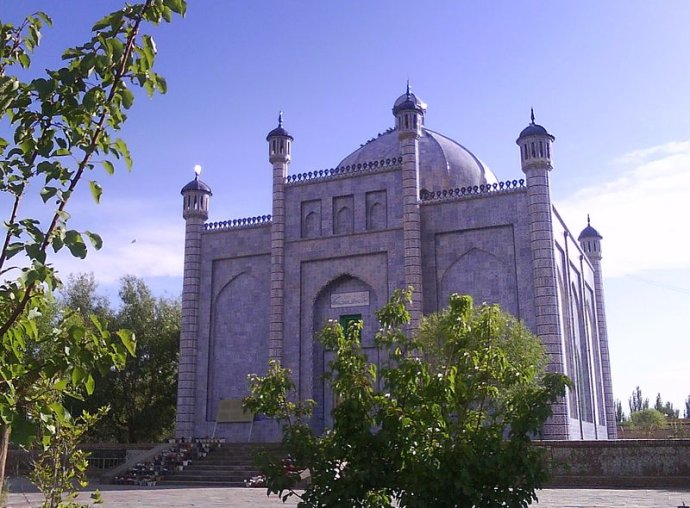
Tomb of Sultan Satuk Bughra Khan, the first Muslim khan, in Artush, Xinjiang Formation of the Kara-Khanid Khanate
During the ninth century, the Karluk confederation (including the Türgesh descended Chigil and Tukshi tribes) and the Yaghma, possible descendants of the Toquz-oguz, joined force and formed the first Karluk-Karakhanid khaganate. The Chigils appear to have formed the nucleus of the Karakhanid army. Historical sources differ on the date of its foundation and the name of its first khan, but the rulers of the Karakhanids were likely to be from the Chigil and Yaghma tribes - the Eastern Khagan bore the title Arslan Qara Khaqan (Arslan "lion" was the totem of the Chigil) and the Western Khagan the title Bughra Qara Khaqan (Bughra "male camel" was the totem of the Yaghma). The names of animals were a regular element in the Turkish titles of the Karakhanids: thus Aslan (lion), Bughra (camel), Toghan (falcon), Böri (wolf), Toghrul or Toghrïl (a bird of prey), etc.[6] Under the Khagans were four rulers with the titles Arslan Ilig, Bughra Ilig, Arslan Tegin and Bughra Tegin.[11] The titles of the members of the dynasty changed with their changing position, normally upwards, in the dynastic hierarchy. In the mid-tenth century the Kara-Khanids converted to Islam and adopted Muslim names and honorifics, but retained Turkic regnal titles such as Khan, Khagan, Ilek (Ilig) and Tegin.[6] Later they adopted Arab titles sultan and sultān al-salātīn (sultan of sultans). According to the Ottoman historian known as Munajjim-bashi, a Karakhanid prince named Satuk Bughra Khan was the first of the khans to convert. After conversion, he obtained a fatwa which permitted him in effect to kill his presumably still pagan father, after which he conquered Kashgar.[12] Later in 960, according to Muslim historians Ibn Miskawaih and Ibn al-Athir, there was a mass conversion of the Turks (reportedly "200,000 tents of the Turks"), circumstantial evidence suggests these were the Karakhanids.[7] Conquest of Transoxiana
At the final decade of the tenth century, the Karakhanids began a struggle against the Samanids for control of Transoxiana, with first a campaign led by d Satuk Bughra Khan's grandson Hasan (or Harun) b. Sulayman (title: Bughra Khan). Between 990-992, the Karakhanids took Isfijab, Ferghana, Ilaq, Samarkand, and the Samanid capital Bukhara. However, Hasan Bughra Khan died in 992 due to an illness, and the Samanids returned to Bukhara. Hasan's cousin Ali b. Musa (title: Kara Khan or Arslan Khan) resumed the campaign against the Samanids, and in 999, Ali's son Nasr retook Bukhara meeting lttle resistance.[6] The Samanid domains were split up between the Ghaznavids, who gained Khorasan and Afghanistan, and the Karakhanids, who received Transoxiana; the Oxus River thus became the boundary between the two rival empires. The Karakhanid state was divided into appanages as was common of Turkic and Mongol nomads. The Karakhanid appanages were associated with four principal urban centers, Balasaghun (then the capital of the Karakhanid state) in Semirechye, Kashgar in Xinjiang (Kashgaria), Uzgen in Fergana, and Samarkand in Transoxiana. The dynasty's original domains of Semirechye and Kashgaria conserved their prestige within the Karakhanid state, and the khagans of these domains retained an implicit seniority over those who ruled in Transoxiana and Fergana.[5] The four sons of Ali (Ahmad, Nasr, Mansur, Muhammad) each held their own independent appanage within the Karakhanid state. Nasr, the conqueror of Transoxiana, held the large central area of Transoxiana (Samarkand and Bukhara), Fergana (Uzgen) and other areas, although after his death his appanage was further divided. Ahmad held Semirechye and Chach, and became the head of the dynasty after the death of Ali. He was succeeded by Mansur.[6] After the death of Mansur, the Hasan Bughra Khan branch of the Karakhanids became dominant. Hasan's sons Muhammad Toghan Khan II, and Yusuf Kadir Khan who held Kashgar, became in turn the head of the Karakhanid dynasty. The two families, i.e. the descendents of Ali Arslan Khan and Hasan Bughra Khan, would eventually spilt the Karakhanid Khanate in two. During the reign of Ahmad b. Ali, the Karakhanids engaged in wars against the non-Muslims to the North-East and East. In 1006, Yusuf Kadr Khan of Kashgar conquered the Kingdom of Khotan.[13] In 1017-1018, the Karakhanids repelled an attack by a large mass of nomadic Turkish tribes, in what was described in Muslim sources as a great victory.[14] The brothers Ahmad and Nasr conducted different policies towards the Ghaznavids in the South - while Ahmad tried to form alliance with Mahmud of Ghazna, Nasr attempted to expand, unsuccessfully, into the territories held by Ghazvanids.[6] 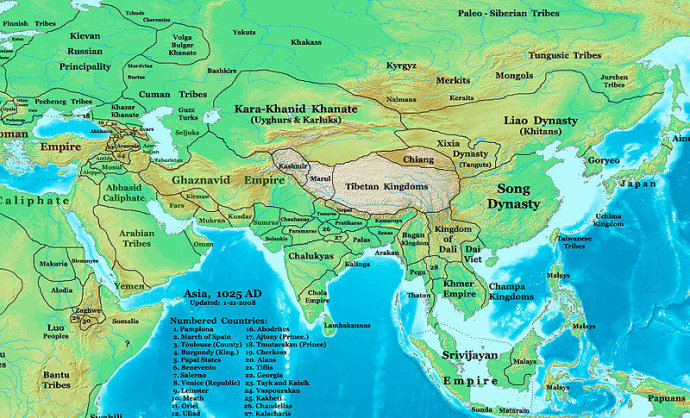
Kara-Khanid Khanate in 1025 AD. Division of the Kara-Khanid Khanate
Early in the 11th century the unity of the Karakhanid dynasty was fractured by frequent internal warfare that eventually resulted in the formation of two independent Karakhanid states. A son of Hasan Bughra Khan, Ali Tegin, seized control of Bukhara and other towns. He expanded his territory further after the death of Mansur. The son of Nasr, Ibrahim Tamghach Bughra Khan, later waged war against the sons of Ali Tegin, and won control of large part of Transoxania, and made Samarkand the capital. In 1041, another son of Nasr b. Ali, Muhammad 'Ayn ad-Dawlah (reigned 1041–52) took over the administration of the western branch of the family that eventually led to a formal separation of the Kharakhanid Khanate. Ibrahim Tamghach Khan was considered by Muslim historians as a great ruler, and he brought some stability to Western Karakhanid Khanate by limiting the appanage system which caused much of the internal strife in the Kara-Khanid Khanate.[6] The Hasan family remained in control of the Eastern Khanate. The Eastern Khanate had its capital at Balasaghun and later Kashgar. The Ferghana-Semirechye areas became the border between the two states and were frequently contested. When the two states were formed, Ferghana fell into realm of the Eastern Khanate, but was later captured by Ibrahim and became part of Western Khanate. 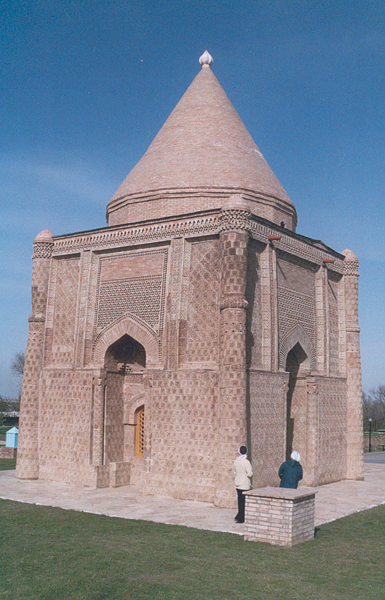
The restored mausoleum of Ayshah bibi near Taraz. Seljuk suzerainty
Dandanaqan, then entered Iran. The Karakhanids were able to withstand the Seljuks initially, and briefly took control of Seljuk towns in Khurasan. The Karakhanids, however, developed serious conflicts with the religious classes (the ulama). In 1089 during the reign of Ibrahim's grandson Ahmad b. Khidr, at the request of the ulama of Transoxiana, the Seljuks entered and took control of Samarkand, together with the domains belonging to the Western Khanate. The Western Karakhanids Khanate became a vassal of the Seljuks for half a century, and the rulers of the Western Khanate were largely whoever the Seljuks chose to place on the throne. Ahmad b. Khidr was returned to the throne by the Seljuks, but in 1095, the ulama accused Ahmad of heresy and managed to secured his execution.[6] The Karakhanids of Kashgar also declared their submission following a Seljuk campaign into Talas and Semirechye, but the Eastern Khanate was a Seljuk vassal for only a short time. At the beginning of 12th century they invaded Transoxiana and even occupied the Seljuk town of Termez for a time.[6] Kara-Khitan Invasion
The Khitans were a Mongolian people of the Liao Dynasty who moved west from Northern China when the Jurchens invaded in 1125 and destroyed the Liao Dynasty. They were led by Yelu Dashi who also recruited warriors from various tribes and moved westward. Yelu occupied Balasagun on the Chu River, then defeated the Western Karakhanids in Khujand in 1137.[15] In 1141 Kara-Khitan Khanate became the dominant force in the region after they defeated Sultan Sanjar, the last Great Seljukid, at the Battle of Qatwan near Samarkand.[5] Several military commanders of Karakhanid lineages such as the father of Osman of Khwarezm, escaped from Karakhanid lands during the Kara-Khitan invasion. The Kara-Khitan Khanate, however, did not destroy the Karakhanid dynasty. Instead, the Khitans stayed at Semirech'e with their headquarter near Balasaghun, and allowed some of the Karakhanids to rule as vassals in Samarkand and Kashgar, with the Karakhanids acting as their tax-collectors and administrators on Muslim sedentary populations (the same practice was adopted by the Golden Horde on the Russian Steppes). The Kara-Khitans were Buddhists and shamanists ruling over a largely Muslim Karakhanids, although they were considered fair-minded rulers whose reign was marked by religious tolerance.[5] Islamic religious life continued uninterrupted and Islamic authority preserved, while Kashgar was a Nestorian metropolitan see and Christian gravestones in the Chu valley appeared beginning this period.[15] However, Kuchlug, a Naiman who usurped the throne of the Kara-Khitan Dynasty, instituted anti-Muslim policies on the local populations under his rule.[16] 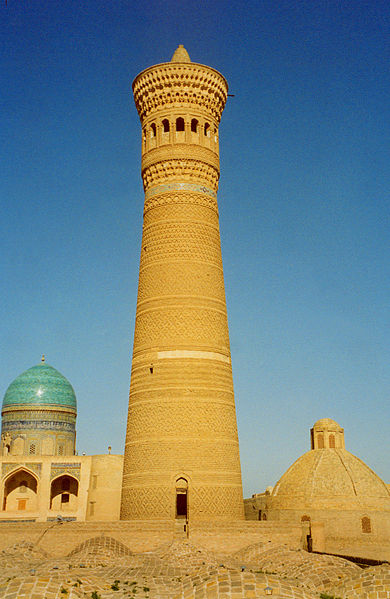
The Kalyan minaret in Bukhara Downfall
The decline of the Seljuks following their defeat by the Kara-khitans allowed the Khwarezmids, previously a vassal of the Kara-Khitans, to expand into former Seljuk territory. In 1207, the citizens of Bukhara revolted against the sadrs (leaders of the religious classes), which the Khwarezm-Shah 'Ala' ad-Din Muhammad used as a pretext for invading and taking Bukhara. Muhammad then formed an alliance with the Western Karakhanid ruler Uthman (who later married Muhammad's daughter) against the Kara-Khitans. In 1210, the Khwarezm-Shah took Samarkand after the Kara-Khitans retreated to deal with the rebellion from the Naiman Kuchlug who had seized the Kara-Khitans' treasury at Uzgen.[6] The Khwarezm-Shah then defeated the Kara-Khitans near Talas. Muhammad and Kuchlug had, apparently, agreed to divide up Kara-Khitan's empire.[17] In 1212, the population of Samarkand staged a revolt against the Khwarezmians, a revolt which Uttman supported, and massacred them. The Khwarezm-Shah returned, recaptured Samarkand and executed Uthman. He demanded the submission of all leading Karakhanids, and finally extinguished the Western Karakhanid state. In 1211, Kuchlug seized the throne of the Kara-Khitans. That same year the last of the Karakhanids in the Eastern Karakhanid state was killed in a revolt in Kashgar, putting an end to Eastern Karakhanid state.[18] In 1218, Kuchlug was killed by the advancing Mongol army, and the territories of the Kara-Khitan taken. The destruction of the Khwarezmian Empire soon followed. Culture
The takeover by the Karakhanids did not changed essentially Iranian character of Central Asia, but it set into motion a demographic and ethnolinguistic shift. During the Karakhanid era, the local population became increasingly Turkic in speech - initially the shift was linguistic with the local people adopting Turkic speech, then the poorer Turks also began to settle.[19] While over the centuries Central Asia became Turkicized, culturally the Turks came close to being Persianized or, in certain respects, Arabicized.[5] The Karakhanids became Persianized to the extent of adopting the "Afrasiab"[citation needed], a Shahnameh mythical figure as the ancestor of their lineage. Nevertheless, the official or court language used in Kashgar and other Karakhanid centers, referred to as "Khaqani" (royal), remained Turkic. The language was partly based on dialects spoken by the Turkic tribes that made up the Karakhanids and possessed qualities of linear descend from the Kök and Uyghur Turkic. The Turkic script was also used for all documents and correspondence of the khaqans according to Dīwānu l-Luġat al-Turk.[20] The Dīwānu l-Luġat al-Turk (Dictionary of Languages of the Turks) was written by a prominent Karakhanid historian Mahmud al-Kashgari who may have lived for some time in Kashgar at the Karakhanid court. He wrote this first comprehensive dictionary of Turkic languages in Arabic for the Caliphs of Baghdad in 1072-76. Another famous Karakhanid writer was Yusuf Balasaghuni who wrote Kutadgu Bilig (The Wisdom of Felicity), an important but the only known literary work written in Turkic from the Karakhanid period.[20] Kutadgu Bilig is a form of advice literature known as mirrors for princes.[21] The Turkic identity is evident in both of these pieces of work but they also showed the influences of Persian and Islamic culture. Islam and its civilization flourished under the Karakhanids. One earliest example of madrasas in Central Asia was founded in Samarkand by Ibrahim Tamghach Khan. Ibrahim also founded a hospital to care for sick as well as providing shelter for the poor.[6] His son Nasr Shams al-Mulk built ribats for the caravanserais on the route between Bukhara and Samarkand, and a palace near Bukhara. Some of the buildings constructed by the Karakhanids still survive today - for example the Kalyan minaret built by Mohammad Aslan Khan beside the main mosque in Bukhara, and three mausolea in Uzgend. The early Karakhanid rulers, as nomads, lived not in the city but in an army encampment outside the capital, and while by the time of Ibrahim the Karakhanids still maintained a nomadic tradition, their extensive religious and civil constructions showed that the culture and traditions of the settled population of Transoxiana had become assimilated.[6]
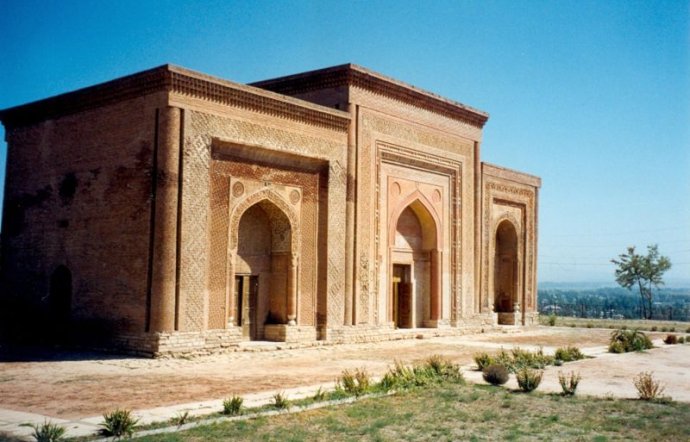
11-12th century Karakhanid mausolea in Uzgen, Kyrgyzstan. Legacy
Kara-Khanid legacy is arguably the most enduring cultural heritage among coexisting cultures in Central Asia from the 9th to the 13th century. The Karluk-Uyghur dialect spoken by the nomadic tribes and turkified sedentary populations under Kara-Khanid rule branched out into two major branches of the Turkic language family, the Chagatay and the Kypchak. The Kara-Khanid cultural model that combined nomadic Turkic culture with Islamic, sedentary institutions spread east into former Kara-Khoja and Tangut territories and west and south into the subcontinent, Khorasan (Turkmenistan, Afghanistan and Northern Iran), Golden Horde territories (Tataristan) and Turkey. The Chagatay, Timurid and Uzbek states and societies inherited most of the cultures of the Kara-Khanids and the Khwarezmians without much interruption. |  |Archiver|小黑屋|丝路遗产丝绸之路:长安天山廊道的路网
( 陕ICP备07011065号-3 )
|Archiver|小黑屋|丝路遗产丝绸之路:长安天山廊道的路网
( 陕ICP备07011065号-3 )